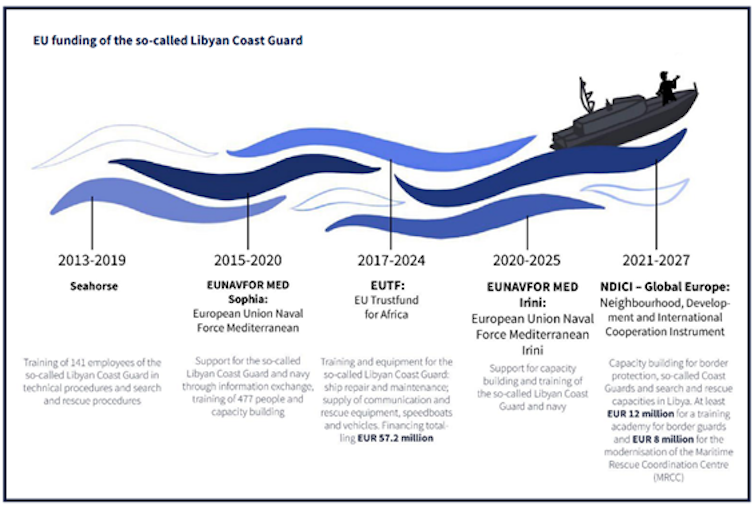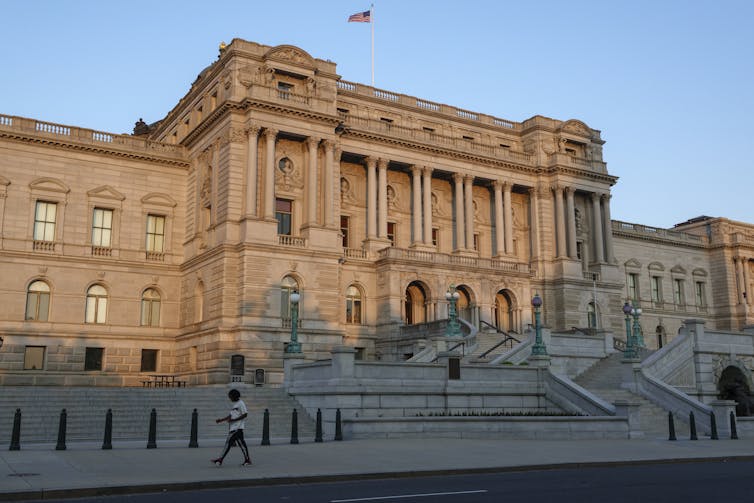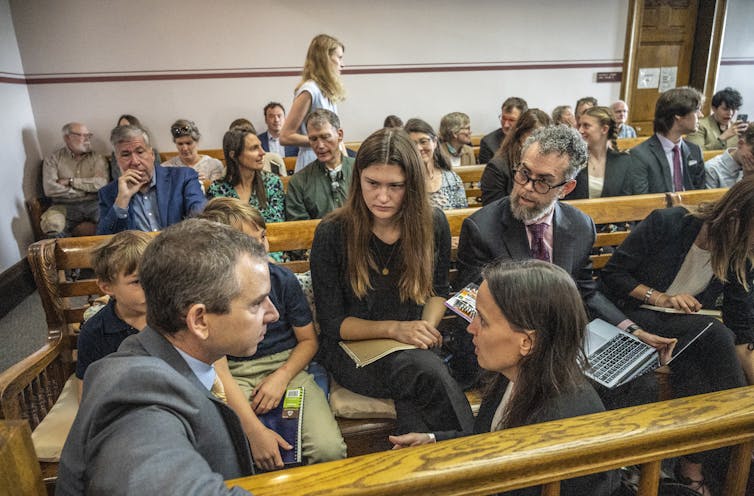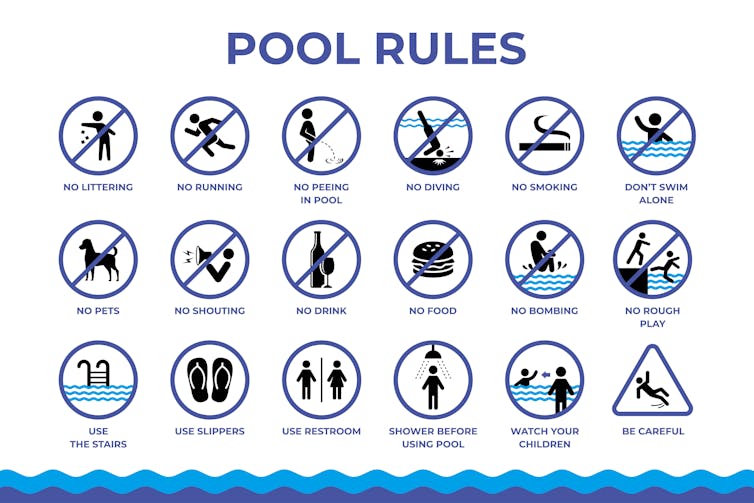Source: The Conversation – France in French (3) – By Morgane Dujmovic, Chargée de recherche CNRS, Géographe et politiste spécialiste des frontières et migrations, Centre national de la recherche scientifique (CNRS)
Cet article est le troisième d’une série en quatre volets consacrée à un travail de recherche mené à bord de l’Ocean Viking, navire de sauvetage de l’ONG SOS Méditerranée. Morgane Dujmovic, géographe et politiste, a recueilli les récits de 110 personnes secourues en Méditerranée centrale pour mieux comprendre leur parcours. Dans cet article, elle revient sur leur parcours en mer. Le dernier épisode est ici. Une version immersive de cette série existe également.
Les dangers de la Libye ne sont généralement découverts que lorsque les personnes en migration y entrent avec l’espoir de trouver une vie décente et du travail.
Périr en Libye ou prendre la mer
« Mon tout premier jour à Tripoli, j’ai su que j’avais pris la pire décision de ma vie. En Libye, ce n’est pas facile de rentrer, mais c’est moins facile encore de sortir ! »,
explique Koné, lors de notre rencontre à Ancône (Italie, côte adriatique).
En effet, rares sont les personnes qui parviennent à transiter moins d’un mois en Libye. La plupart de celles et ceux que nous avons rencontrés sur l’Ocean Viking (OV) (57,9 %) y ont totalisé entre un et six mois. Certaines s’y sont retrouvées piégées plus de deux ans – jusqu’à sept années cumulées, pour un participant soudanais.
Dans le panorama statistique offert par l’enquête, on voit se dessiner des routes et des configurations migratoires différentes, les longs séjours subis en Libye concernant surtout les personnes des pays les plus pauvres et déchirés par des guerres.
On voit surtout que les femmes sont bloquées plus durablement en Libye : celles que nous avons rencontrées y ont passé en moyenne quinze mois et demi, contre huit mois et demi pour les hommes. On peut y voir l’effet des mécanismes de contrainte et de violence qui s’appliquent spécifiquement aux femmes en migration en Méditerranée, comme l’a parfaitement décrit la géographe Camille Schmoll dans son ouvrage les Damnées de la mer (2022).
Dans les conditions de survie qui ont été rapportées, la décision de prendre la mer malgré les risques de la traversée peut se résumer ainsi : préférer le risque de mourir maintenant plutôt que la certitude de perdre la vie à petit feu.
« Sept mois » : l’expérience de la Libye de Mohamad

Fourni par l’auteur
Sur sa carte, Mohamad a bien montré ce glissement. On y voit les violences cumulatives qu’il a rencontrées sur son parcours de l’est à l’ouest de la côte libyenne : la captivité à Tobruk chez un « marchand d’humains », l’enfermement et le vol à Benghazi, le racisme et la xénophobie à Ajdabiya, les mauvais traitements à Zouara, d’où il a finalement réussi à fuir par la mer.
Son illustration montre, de droite à gauche, l’enchaînement de faits qui l’a conduit de l’enfermement au bateau.
Pour parvenir à prendre la mer, il faut toutefois réunir une somme d’argent considérable. Les personnes participantes mentionnent des emprunts à leur famille de 2 000, 6 000, voire 10 000 dollars, pour s’acheter une place sur un bateau. Celle-ci est parfois obtenue à la suite de travaux forcés depuis les prisons plus ou moins officielles, ou contre la promesse d’être celui qui conduira le bateau.
Lorsque les tentatives se heurtent à des interceptions suivies de refoulements vers la Libye, il faut rajouter à la somme initiale :
« Ils m’ont escroqué d’abord 2 000 dollars, puis 3 000 et, la troisième fois, j’ai payé 5 000 dollars. »

Alisha Vaya/SOS Méditerranée, Fourni par l’auteur
Des personnes participantes à l’étude ont également décrit leurs conditions de vie dans la game house (les bâtiments collectifs où les personnes ayant payé leur traversée attendent le signal du départ). Ces séjours durent de plusieurs jours à plusieurs semaines, avec des approvisionnements et modalités variables selon les circuits et les montants payés pour arriver là. Mais toutes témoignent d’une même découverte à leur première tentative de traversée : celle de la nature des embarcations, impropres à la navigation et surchargées. Comme l’a expliqué Koné, à ce stade, il est généralement trop tard pour faire demi-tour :
« On a démarré d’une plage à côté de Tripoli, à 4 heures du matin, on nous a fait courir sur l’eau : “Go, go !” C’était trop tard pour changer d’avis. »
Perte de repères dans la nuit de la mer
Le départ depuis les plages libyennes se fait souvent de nuit, et ce n’est qu’au matin qu’on découvre l’immensité de la mer. L’enquête par questionnaire a justement permis d’étudier les perceptions des personnes placées sur ces embarcations en détresse au cours des scènes de sauvetage. Le premier résultat qui interpelle est leur perte de repères au moment où elles sont secourues.
L’un des participants a ainsi mentionné « la simple joie d’avoir trouvé quelque chose dans l’eau », en se remémorant sa première impression à la vue de l’Ocean Viking à l’horizon. D’autres participants ont décrit à quel point leurs perceptions étaient troublées par les conditions de navigation ou par la nature même des embarcations, comme cette personne bangladaise qui avait pris la mer dans la cale d’un bateau en bois :
« J’étais à l’intérieur du bateau en bois, je ne pouvais rien voir ou entendre. Je ne croyais pas que c’était un sauvetage jusqu’à ce que je sorte et voie avec mes propres yeux. »
Charlie, le SAR Team Leader qui a coordonné ce sauvetage, se souvient de sa propre stupéfaction à la découverte des 68 personnes à bord, sur une embarcation prévue pour 20 :
« À mesure qu’on les transférait sur nos RHIB (bateaux semi-rigides), d’autres sortaient de dessous le pont, cachés. »
En m’appuyant sur le questionnaire, les ateliers cartographiques et des entretiens ciblés, j’ai tenté de reconstituer l’espace-temps de ce sauvetage avec les personnes secourues et des membres de l’équipage.
« Ils retournaient droit vers Tripoli ! »
Jérôme, le coordinateur adjoint de la recherche des secours à bord (ou Deputy SARCo) de l’OV, a confirmé le cas d’une embarcation « extrêmement surchargée », comme l’indique le rapport final de sauvetage :
« Là, ils étaient chargés ! L’alerte nous annonçait 55 personnes à bord, et nous on en a trouvé 68, parce qu’il y a ceux qui étaient sous le pont, cachés ! »
Dans le poste de commande de l’OV, écran de veille à l’appui, nous avons retracé les positions du bateau au fil de sa recherche. Ce matin-là, l’alerte avait été donnée par Alarm Phone, une ligne téléphonique citoyenne qui opère en continu depuis les deux rives de la Méditerranée, notamment pour relayer et suivre les cas de détresse.
« On a reçu une position à 6 h 19. On a tenté d’appeler Tripoli plusieurs fois, ça ne répondait pas. On a dit : “On y va quand même, on est très inquiets.” On a lancé le mail officiel disant qu’on y allait. »
Une fois ces démarches accomplies auprès des centres de coordination et de sauvetage en mer, l’OV s’est dirigé vers la position donnée, dans les eaux internationales au large de la ville libyenne de Zouara.
Peu de temps après, nos radios réglées sur le canal de veille ont grésillé :
« On réveille tout le monde en général quand on arrive dans les dix milles, c’est la distance avec laquelle on peut les trouver avec les jumelles. Et à 6 heures, il commence à y avoir les premières lueurs de l’aube. »
La recherche de l’embarcation en détresse s’est toutefois compliquée :
« Avec les premières données, le point de départ et la deuxième position, on avait une indication sur la vitesse : on pensait qu’ils faisaient 5 nœuds. Donc on s’est dit qu’on allait les trouver à cette position. Sauf qu’une fois arrivés, on a commencé à s’arracher les yeux : ils n’étaient pas à la position ! »

Morgane Dujmovic, Fourni par l’auteur
Les calculs opérés dans cette phase de recherche doivent en effet intégrer des facteurs multiples, parmi lesquels les différentes positions reçues (quand il y en a), mais aussi la présence ou l’absence d’un moteur fonctionnel et, enfin, les conditions météorologiques et maritimes, comme l’a expliqué Jérôme :
« Ce que je pense, c’est qu’ils ont dû se perdre et se dérouter : en ayant la mer, le vent dans la figure, tu ne sais pas où tu vas. Je pense qu’ils ne voyaient rien de ce qu’ils faisaient. Ils étaient en train de lutter avec tout ça. »
Confirmant les hypothèses de Jérôme, beaucoup des personnes secourues ce jour-là sont arrivées sur le pont de l’OV en souffrant de déshydratation et de mal de mer :
« Comme on l’a vu sur les photos, ils avaient vraiment beaucoup de houle et de vent qui leur arrivait dans la figure. Plus tu vas vers le large, plus tu subis la mer. »
Devant les zooms et dézooms opérés par Jérôme à l’écran, je comprends en images les implications d’un cas de détresse en mer au large de la Libye :
« En plus, là, le vent suffisait à les faire dériver : ils retournaient droit vers Tripoli ! »
« Ces bateaux ne devraient même pas exister »
Malgré les difficultés décrites pour ce sauvetage, il correspond à une opération « à faible risque ». Des événements plus critiques sont régulièrement rapportés par les équipages et par les personnes secourues.
Au fil du temps, les équipes de sauvetage ont notamment vu la qualité des embarcations se dégrader, comme l’explique Jérôme :
« Il y a eu les “wooden boats” (bateaux en bois), puis les “rubber boats” (bateaux pneumatiques). Maintenant, les pires c’est les “iron boats” (bateaux en métal). »
En 2023, des embarcations en métal soudées à la hâte ont commencé à faire leur apparition au large de la Tunisie. Pour les marins aguerris qui forment les équipes de sauvetage, comme Charlie, l’existence même de telles embarcations en pleine mer est difficilement concevable :
« Ces bateaux ne devraient même pas exister. Ils ont des structures extrêmement faibles. Ils sont faits à la main, mal et vite faits ; ce sont juste des plaques en métal, soudées. Ils n’ont pas de stabilité. Ce sont comme des cercueils flottants. »
Pour ces professionnels de la mer, l’inquiétude est réelle : « Il faut que nous soyons préparés à ça. » D’une part, les bords acérés des bateaux en métal peuvent abîmer les bateaux semi-rigides (RHIB) de l’ONG, avec le risque de compromettre l’ensemble de l’opération de sauvetage – comme cela s’est produit en septembre 2023, à l’issue d’une patrouille sur la route tunisienne. Les RHIB avaient alors été protégés « avec les moyens du bord », à l’aide des tapis trouvés sur le navire alors qu’il était en opération en mer.
D’autre part, chaque nouveau type d’embarcation implique des techniques très spécifiques. L’approche et le positionnement des bateaux semi-rigides autour de l’embarcation en détresse (ou « danse des RHIB »), les modes de communication propices au maintien du calme, les soins d’urgence durant le transfert vers le bateau-mère : tout cela est étudié avec minutie afin d’anticiper un maximum de scénarios.
Dans la salle de repos de l’équipage, face à la maquette construite par les anciens de SOS Méditerranée pour s’entraîner aux simulations, Charlie m’a longuement expliqué les techniques développées pour approcher chaque type d’embarcation en détresse, selon qu’elles sont en fibres de verre, en bois, en pneumatique ou en métal.
Dans le dernier cas, celui d’un bateau en métal, Charlie a insisté sur les implications critiques d’un sauvetage qui tournerait mal :
« Les bateaux en métal peuvent chavirer à tout moment et couler rapidement, à pic. Dans ce cas, la scène ressemblerait à ça : un massive MOB ! »,
c’est-à-dire un « Man Over Board » (« homme à la mer ») de grande ampleur, impliquant le passage par-dessus bord d’un nombre important de personnes. C’est ce que sont venus illustrer les petits objets bleus dispersés sur sa maquette.

Morgane Dujmovic, Fourni par l’auteur
Se noyer plutôt qu’être capturé
Une autre donnée a rendu les activités de sauvetage de plus en plus ingérables au fil du temps : les activités des milices et « garde-côtes libyens » dans la SRR (Search and Rescue Region) libyenne, c’est-à-dire la région libyenne de recherche et sauvetage en mer créée en 2018 avec le support de l’Union européenne.
Deux autorités y sont chargées de la surveillance côtière : la garde côtière libyenne (LCG) dépendant du ministère de la défense, et l’administration générale de la sécurité côtière (GACS), rattachée au ministère de l’intérieur.
Les multiples agissements illégaux et violents rapportés au sujet des acteurs libyens en mer ont justifié l’emploi de plus en plus courant de guillemets pour les désigner, ou de l’expression « so-called Libyan Coast Guard ». Pourtant, ces groupes reçoivent un soutien abondant de l’Union européenne et de plusieurs de ses États membres.

Humanity Overboard, SOS Humanity, p.11, Fourni par l’auteur
À bord de l’OV, les témoignages ne tarissent pas sur les manœuvres périlleuses des « garde-côtes libyens » visant explicitement à faire échouer les sauvetages, comme l’a soulevé Charlie :
« Je les ai vus faire des manœuvres folles, essayer de rendre le sauvetage aussi dur que possible, en nous empêchant de secourir, en criant, en hurlant. »
Plusieurs microscènes de ce type ont été reconstituées :
« Ils conduisent le plus près et le plus rapidement possible pour créer des vagues. Ils se mettent sur notre route, interfèrent, près du bateau-mère. »
Quand les acteurs libyens sont sur scène, l’explosion d’émotions liées à l’arrivée des secours peut se transformer en scène de panique et affecter les chances de réussite du sauvetage.
Ce sont 31,4 % des personnes participantes à l’étude qui ont ainsi exprimé une perception négative à la vue d’un navire à l’horizon, associée à la peur d’être interceptées et refoulées par les acteurs libyens en mer :
« Au loin, nous ne savions pas si c’était un bateau de sauvetage ou les garde-côtes libyens. C’était un stress énorme à bord, les gens criaient et les enfants pleuraient. Nous étions prêts à sauter. »
En effet, la présence des autorités libyennes est souvent perçue comme un danger plus grand que le risque de noyade, comme l’a résumé l’un des participants :
« Pour moi, le danger ce n’est pas la mer, ce sont les autorités libyennes. »
Ce positionnement s’explique aisément pour les personnes qui ont déjà expérimenté une ou plusieurs interceptions. Certaines des personnes participantes à l’étude ont mentionné des violences exercées au cours de leur refoulement vers la Libye, telles que des coups, des menaces armées, des vols d’argent, des privations d’eau et de nourriture, voire des actes mortels :
« La première fois que j’ai pris la mer, les Libyens ont tiré sur le moteur, le carburant a brûlé et explosé et les gens près de moi sont morts. »
En outre, la proximité des « garde-côtes libyens » avec des milices ou réseaux mafieux est notoire. L’un des répondants à l’étude a décrit en ces termes l’administration générale de la sécurité côtière (GACS) :
« Il y a toujours un risque que le GACS, un groupe armé avec des masques, vous mette en prison. »
Les interceptions sont généralement suivies de périodes de détention arbitraire en Libye, dans les conditions inhumaines détaillées précédemment (voir la partie 2 de cette série) :
« J’ai essayé de traverser quatre fois mais j’ai été attrapée et mise en prison avec mon enfant ; j’ai beaucoup souffert. »

Morgane Dujmovic, Fourni par l’auteur
Ces faits rapportés par les équipages et personnes secourues sont largement étayés par les organisations internationales, humanitaires ou les collectifs associatifs qui suivent la situation en Méditerranée centrale. Dans son rapport de mission d’enquête de 2021, le Conseil des droits de l’homme des Nations unies laisse peu de doutes quant à la chaîne de causalité qui relie les interceptions en mer et la traite des personnes migrantes en Libye :
« Les garde-côtes libyens procèdent […] à l’interception de l’embarcation dans des conditions violentes ou périlleuses, qui se soldent parfois par des morts. […] Les garde-côtes libyens confisquent les effets personnels des migrants à bord. Une fois débarqués, les migrants sont soit transférés dans des centres de détention, soit portés disparus, et il semblerait que certains soient vendus à des trafiquants. […] Depuis que des bateaux sont refoulés en Méditerranée, les autorités libyennes ont été averties du caractère généralisé et systématique des interceptions périlleuses effectuées en mer et des violences commises dans les centres de détention. Plutôt que d’enquêter sur ces cas et de remédier à ces pratiques, les autorités libyennes ont continué à intercepter les migrants et à les placer en détention. »
En croisant ces scènes de sauvetage maritime avec le vaste système d’exploitation organisé depuis les lieux de détention en Libye, on comprend que l’interception en mer par les « garde-côtes libyens » relève d’une stratégie de capture, et que la Méditerranée centrale est devenue le lieu d’un corps à corps pour la sauvegarde de la vie et de la dignité humaine.
![]()
Morgane Dujmovic ne travaille pas, ne conseille pas, ne possède pas de parts, ne reçoit pas de fonds d’une organisation qui pourrait tirer profit de cet article, et n’a déclaré aucune autre affiliation que son organisme de recherche.
– ref. À bord de l’« Ocean Viking » (3) : échapper à la Libye, survivre à la mer – https://theconversation.com/a-bord-de-l-ocean-viking-3-echapper-a-la-libye-survivre-a-la-mer-257662

















